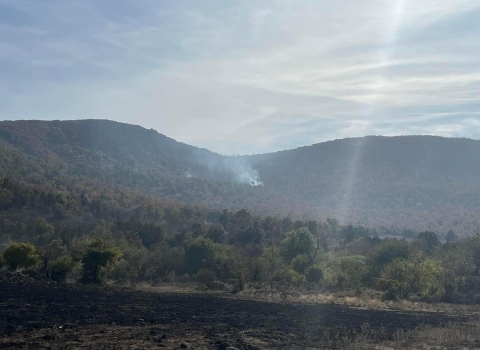The U.S. Fish and Wildlife Service announced today it has completed a status review of the black-tailed prairie dog and has determined it does not warrant protection as a threatened or endangered species under the Endangered Species Act. The Service made this finding after a thorough review of all the available scientific and commercial information regarding the status of the black-tailed prairie dog and the potential impacts to the species.
Black-tailed prairie dogs are typically found east of the continental divide in the states of Montana, Wyoming, South Dakota, North Dakota, Oklahoma, Texas, Arizona, New Mexico, Colorado, Kansas, and Nebraska. Prairie dogs were extirpated in Arizona in the early 1960s; however, 74 prairie dogs were reintroduced into the State in October and further reintroduction efforts are anticipated.
The Service assessed potential impacts to the black-tailed prairie dog including conversion of prairie grasslands to croplands; large-scale poisoning; and sylvatic plague.
Most estimates of black-tailed prairie dog populations are not based on numbers of individual animals, but on estimates of occupied habitat. The most current rangewide estimate of occupied habitat is 2.4 million acres. While considerably reduced from historic estimates of 80 to 100 million acres rangewide, black-tailed prairie dog habitat has increased significantly since its lowpoint of 364,000 acres in 1961.
Cropland conversion, urbanization, energy development, and invasion of non-native species all occur within the historical range of the black-tailed prairie dog and will continue in the future. However, with 283 million acres of available rangeland, it appears sufficient potential habitat still occurs within the range of the species in the U.S. Additionally, increasing population trends do not suggest these impacts are limiting factors for the species.
Recreational shooting of black-tailed prairie dogs can reduce population densities; however, available information indicates that populations can recover from very low numbers following intensive shooting. Recreational shooting does not appear to have a significant impact on black-tailed prairie dogs at statewide or rangewide levels.
In recent years, plague has expanded its range to all States within the range of the black-tailed prairie dog and has caused local population declines at several sites. These declines are typically followed by partial or complete recovery. Population trends and recent statewide estimates of occupied habitat indicate that populations can remain stable or increase despite the presence of plague within much of the range of the species.
Currently available information concludes that black-tailed prairie dog colony size increases by about 30 percent annually for several consecutive years following poisoning, and after intense but not total elimination, colony size can initially increase by as much as 70 percent.
Occupied habitat appears to be steady to increasing since 1961 despite the presence of plague, poisoning, and other impacts.
Climate change will likely affect black-tailed prairie dogs and their habitat; however, at this time we have no information on the direct relationship between climate change climate change
Climate change includes both global warming driven by human-induced emissions of greenhouse gases and the resulting large-scale shifts in weather patterns. Though there have been previous periods of climatic change, since the mid-20th century humans have had an unprecedented impact on Earth's climate system and caused change on a global scale.
Learn more about climate change and black-tailed prairie dog population trends and cannot quantify the potential magnitude or extent that climate change may have on the species.
The primary means by which agencies can effectively manage black-tailed prairie dog populations are through regulation of shooting and poisoning, and practicing proactive management. All States within the range of the black-tailed prairie dog have to varying degrees incorporated black-tailed prairie dog conservation policies in their management plans.
In March 2008, WildEarth Guardians filed a complaint against the Service for failure to complete a finding on their August 2007 petition to list the black-tailed prairie dog. In a July 2008 stipulated settlement, the Service agreed to submit a finding on the petition by November 30, 2008 and a status review finding by November 30, 2009.
For more information regarding the black-tailed prairie dog, please visit our web site at http://www.fws.gov/mountain-prairie/species/mammals/btprairiedog/
Prairie dogs are small, stout ground squirrels. The total length of an adult black-tailed prairie dog is approximately 14-17 inches and the weight of an individual ranges from 1 to 3 pounds. Individual appearances within the species vary in mixed colors of brown, black, gray, and white. The black-tipped tail is characteristic. Black-tailed prairie dogs are diurnal, burrowing animals. They do not hibernate as do white-tailed, Gunnison’s, and Utah prairie dogs. The black-footed ferret, swift fox, mountain plover, ferruginous hawk, burrowing owl, and numerous other species are dependent upon prairie dogs to varying degrees.


